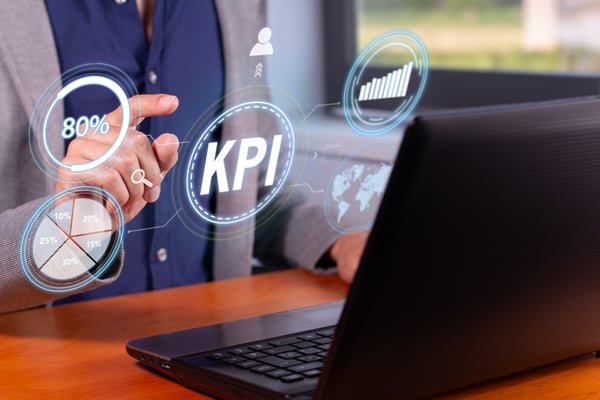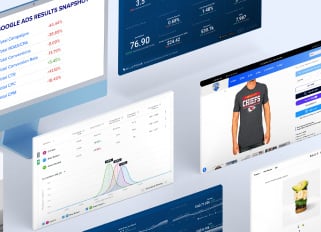.jpg)
How E-Commerce Businesses Succeed with Data-Driven Strategies
Data is everywhere, but how businesses turn raw numbers into actionable choices sets industry leaders apart. Modern organizations no longer rely on gut feeling alone; instead, they use data-driven decision-making and structured processes to collect reliable information, uncover trends, and guide strategic moves.
In this article, you will learn how to:
- Gather and validate the right data sources
- Apply analysis methods and choose the best tools
- Translate insights into action plans aligned with your goals
- Measure impact through KPIs and a solid ROI framework
Whether you are refining an existing analytics program or just getting started, this guide will show you the practical steps top teams use to turn data into data-driven decisions that drive growth and agility.
Let’s begin by exploring the core principles of data-driven decision making.
1. Understanding Data-Driven Decision-Making
Wondering what is data driven decision making, what data-driven decision making or what data-driven decision-making is? It refers to the practice of using objective insights, analysis, and evidence to guide strategic and operational choices.
By collecting and analyzing relevant metrics, teams identify patterns, trends, and opportunities, moving beyond intuition to evidence-based actions. This approach supports strategic planning and long-term vision by enabling scenario analysis and forecasting future trends.
Data-driven decisions vs data-driven decision-making
The term data-driven decisions often refers to specific outcomes shaped by data. Data-driven decision-making describes the end-to-end process, from gathering metrics to interpreting results. Both emphasize reliance on factual information over guesswork.
Why Data-Driven Strategies Matter for Modern Businesses
Adopting a data-driven approach minimizes risk, uncovers efficiencies, and fosters continuous improvement. In today’s competitive landscape, using real-world metrics ensures greater agility and better outcomes.
2. The Process of Turning Data into Decisions
Turning data into strategic choices requires three steps: collection, analysis, and action. Each phase builds on the last to make data-driven decisions that align with business goals.
Data Collection
Gather raw data from internal systems, social media, PR monitoring, and market research. While doing this, focus on consistency and completeness to avoid blind spots.
Ensuring Quality Control
Validate sources, remove duplicates, and standardize formats. Don’t forget early checks eliminate errors before they affect downstream analysis!
Data Analysis
Apply statistical methods, sentiment scoring, and trend detection to uncover patterns. It’s also important to have visual dashboards to help stakeholders grasp insights quickly.
In service industries like HVAC, specialized platforms help centralize customer data, job performance metrics, and technician insights within a single system. This allows business owners to monitor KPIs like first-time fix rates, job durations, and revenue per technician in real time, turning day-to-day operational data into informed staffing decisions, targeted training, and pricing adjustments.
Selecting the Right Tools
Choose business intelligence platforms, scripting languages, or machine learning libraries based on data volume and complexity.
Interpretation and Action
Translate analytical results into clear recommendations. Moreover, frame insights around objectives and constraints to drive effective execution.
Aligning Insights with Goals
Prioritize actions that have a measurable impact on KPIs. On top of that, close feedback loops to refine tactics and improve future data-driven decisions. Every data-driven decision should link to a clear objective and measurable outcome..jpg?width=600&height=400&name=unnamed%20(6).jpg)
3. Essential Components for Success
Data Collection & Quality Assurance
Effective decision-making starts with reliable inputs. Establish a data governance committee to set standards, policies, and procedures. Next, implement automated monitoring tools and scheduled cleansing routines to catch errors in real time. This ensures data remains accurate, consistent, and timely across teams.
Analytical Methods & Tools
Modern businesses leverage predictive analytics and business intelligence platforms to turn raw figures into insights. For instance, AI and machine learning engines help detect patterns and forecast trends. This unified approach ensures every data-driven decision relies on consistent, high-quality input.
Interpretation & Action Plans
Translating data insights into tangible actions requires a clear framework. Define the business need, map relevant data sources, and assign accountability for each recommendation. Regularly measure outcomes against key performance indicators to close the loop and drive continuous improvement in data-driven decision making.
4. Tools and Technologies Powering Decisions
Business Intelligence & Dashboards
CisionOne delivers interactive BI dashboards in a cloud native comms platform. Teams can track headline mentions, readership levels, sentiment breakdown, and share of voice across print, online, TV, and social media.
Custom charts, unlimited keyword searches, and one-click shares via Slack or email keep insights at your fingertips on desktop, tablet, or mobile.
AI & Machine Learning
Cision’s AI features include React Score, which uses 17 NLP models to flag harmful or spam content in real time. Narrative analysis groups similar opinions and spots influential voices. The upcoming stance feature adds context-aware sentiment for deeper interpretation.
Real-Time Data Analytics
A built-in streaming engine monitors media coverage across multiple channels instantly. Real-time feeds power low-latency reports and alerts, so teams can respond to emerging trends, opportunities, or crises without delay.
5. Best Practices and Common Mistakes
Fostering a Data-Centric Culture
- Involve stakeholders from marketing, finance, and operations in strategy workshops.
- Offer basic data literacy training so everyone understands key metrics and dashboards.
- Embed insights into regular team meetings and decision forums.
Ensuring Data Quality and Governance
- Assign ownership to roles for data validation and stewardship.
- Implement automated checks to flag duplicates, outdated records, and inconsistencies.
- Establish clear policies for access, retention, and compliance.
Aligning Data Initiatives with Business Goals
- =Define success criteria before collecting data to avoid costly bloat.
- Prioritize projects that address measurable outcomes, such as reducing churn or improving campaign ROI.
- Centralize data through integrated warehouses and ETL pipelines for a unified customer view.
Common Pitfalls to Avoid
- Treating data as an IT-only responsibility, which creates silos and slows adoption.
- Gathering metrics without defined objectives, leading to unused datasets.
- Relying on static dashboards without clear action plans.

6. Measuring Impact: ROI and KPIs
Defining an ROI Framework
Start by mapping success metrics to strategic objectives. Sum software fees, cloud storage, equipment, training, and other costs to calculate total ROI. Include intangible benefits, such as competitive advantage, regulatory compliance, and innovation potential, for a comprehensive assessment.
Selecting and Tailoring KPIs
Choose KPIs that reflect each use case. For operational efficiency, track cycle time, capacity utilization, and time-to-market. For customer engagement, monitor conversion rate, retention, and share of voice.
Continuous Improvement Loop
Set regular review intervals to compare KPI trends against ROI targets. Refine data collection, adjust benchmarks, and iterate on insights to drive ongoing gains and better data-driven decisions.
7. Innovative Strategies for Next-Gen Decision-Making
Decision Intelligence & Automation
Decision intelligence platforms unify data from hundreds of sources and automate routine tasks like data processing and reporting. This frees teams to focus on strategy and uses predictive models for real-time insights.
Data Storytelling Techniques
Craft clear narratives with dashboards, charts, and interactive reports so stakeholders grasp complex insights. Story frameworks link data patterns to business goals for faster alignment and execution.
Responsible & Ethical Data Use
Implement robust governance covering privacy, consent, and compliance. Ethical data practices build trust, reduce risk, and ensure analytics respect regulations.
8. Future Trends and Case Studies: Cision in Action
Emerging Trends Shaping the Landscape
Self-service analytics and data democratization are transforming how communication teams operate. Modern platforms now enable nontechnical users to create custom reports and dashboards, fostering faster collaboration and reducing time-to-insight. The 2025 State of the Media Report highlights data-driven strategies that help PR professionals refine their outreach and improve media coverage outcomes.
Case Studies: Real World Examples of PR Success
-
Simmons Bank revamped its investor relations site and retained recognition on Forbes' “America’s Best Banks” list.
-
The Center for Environmental Health expanded national visibility and furthered its mission through strategic media outreach.
-
MoneyGram utilizes real-time media monitoring to stay responsive to evolving consumer needs.
-
Ellisphere, a 125-year-old French firm specializing in data marketing and risk management, enhanced compliance and decision-making through integrated analytics tools.
Conclusion
Turning data into decisions is a proven path that starts with reliable inputs and ends with measurable impact. Modern businesses succeed by combining governance, the right tools, and a culture that values insights.
Key takeaways include:
- Establish data governance and quality checks to ensure accuracy
- Use analytics methods and AI-driven platforms to detect patterns and forecast trends
- Frame insights around strategic goals and make data-driven decisions with defined action plans and KPIs
- Calculate ROI comprehensively and refine processes through continuous feedback loops
- Embrace decision intelligence, data storytelling, and ethical standards for next-level performance
By following these steps, your team can move from intuition to evidence-based choices that drive growth, agility, and innovation. Data shapes the future. Make data-driven decisions to shape yours.
-1.jpg?width=280&height=241&name=unnamed%20(5)-1.jpg)
Megan Isola
Megan Isola holds a Bachelor of Science in Hospitality and a minor in Business Marketing from Cal State University, Chico. She enjoys going to concerts, trying new restaurants, and hanging out with friends.
Connect With Us
Recent Post

.png)





Tell us what you think!